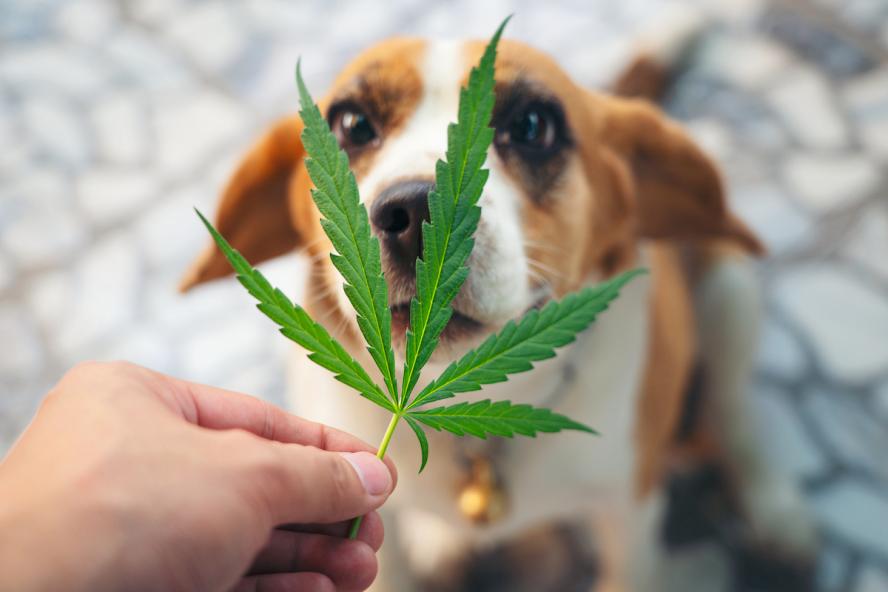-
About
- Leadership & Faculty
- News & Events
-
Academics
- Graduate
- Advanced Clinical Training
- Continuing Education
- Academic Departments
- Academic Offices
- Simulation Experiences
-
Student Life
- Offices
-
Research
-
Hospitals & Clinics
- Emergency Care
- Hospital Services
-
Community Outreach
- Volunteer
Marijuana Toxicosis in Pets
Ask the Expert

How can my pet be exposed to marijuana and what precautions can I take to avoid exposure?
As the legalization of marijuana expands, veterinary emergency rooms are seeing an increase in marijuana toxicosis cases1. Marijuana toxicosis in dogs and cats most commonly occurs via ingestion, although inhalation can also cause clinical signs3. Pets can be exposed by ingesting edible marijuana products, plant material, or by eating food cooked with marijuana products. Many cases are unwitnessed and owners may report no known access. In these cases, a pet may have gone for a walk or been outside prior to the onset of clinical signs, likely indicating exposure was from ingesting something while outside.
To decrease the chance of exposure, eliminate access as much as possible. If marijuana is present in the home, secure it so it is inaccessible to your pet. If marijuana products are used in cooking, do not feed any cooked products to pets and take out the trash immediately after cooking.
What are the signs that a pet may be suffering from marijuana toxicity?
Clinical signs from ingestion typically develop within 30 minutes to several hours after exposure and can last up to 72 hours3. These signs can differ based on the type and amount ingested. A recent survey of veterinarians found the most common clinical signs were urinary incontinence, disorientation, drunken gait, lethargy, hyperesthesia (increased reactivity), and low heart rate2. For synthetic marijuana cases, tremors and seizures may also be reported.
While most cases are mild, the recent survey shows increasing veterinary reports of fatalities from suspected marijuana ingestion. This is likely due to a corresponding increase in the THC concentration now found in marijuana products, sometimes as high as 80–90 percent THC3. Severely affected patients could be in a comatose state with low respiratory rate, seizures, or absent gag reflex.
What testing is available to confirm marijuana exposure?
Unfortunately, there is no timely, reliable diagnostic test for THC exposure. Many veterinarians utilize the human urine drug screening test, as it is the only bedside test available2. However recent findings call into question the validity of their use in veterinary patients4. First, the test was designed to detect the urine metabolites found in human patients. Since veterinary patients metabolize THC to additional metabolites not found in humans, a negative test does not rule out exposure. Second, inappropriate sample handling can lead to false negatives. THC can bind to the glass and rubber found in some urine sample containers, which would lead to a false negative.
If suffering the effects from marijuana toxicosis, how is it treated?
Current treatment recommendations, especially for mild cases, focus on supportive care. Decontamination, such as inducing vomiting and activated charcoal, is not recommended if a patient is already symptomatic due to the risk of aspiration. Supportive care typically includes intravenous fluid therapy and protection from bodily harm.
For more severely affected patients, intravenous lipid therapy or hemodialysis5 can be considered. Intravenous lipid therapy remains controversial due to inconsistent clinical outcomes reported and lack of understanding on the mechanism of action in toxicity cases6. More research is needed to improve our ability to detect and treat these patients. At Cummings School, we are enrolling dogs in a randomized controlled trial looking at the efficacy of intravenous lipid therapy with moderate to severe marijuana toxicosis.
Can proper treatment avoid significant damage?
For mild to moderate cases, the prognosis is excellent with almost all patients making a full recovery. Depending on the severity of clinical signs, supportive care at home may be enough to support them through recovery. However, for severely affected patients, at-home care is unlikely to be adequate. These patients may require intensive care with ventilation due to respiratory depression, aspiration pneumonia, and uncontrolled seizures. Even with intensive care, these patients’ lives are at risk.
References
- Meola et al. Evaluation of trends in marijuana toxicosis in dogs living in a state with legalized medical marijuana: 125 dogs (2005–2010). JVECC 2012; 22, 690–696
- Amissah et al. (2022). Prevalence and characteristics of cannabis-induced toxicosis in pets: Results from a survey of veterinarians in North America. PLOS ONE, 17, 1–18.
- Brutlag, A., & Hommerding, H. (2018). Toxicology of marijuana, synthetic cannabinoids, and cannabidiol in dogs and cats. Veterinary Clinics: Small Animal Practice; 48, 1087–1102.
- Fitzgerald et al. (2021). Detecting and quantifying marijuana metabolites in serum and urine of 19 dogs affected by marijuana toxicity. Journal of Veterinary Diagnostic Investigation, 33:1002–1007.
- Culler, C. & Vigani, A. (2019). Successful treatment of a severe cannabinoid toxicity using extracorporeal therapy in a dog. JVECCS, 29, 674–679
- Gwaltney-Brant, S. & Meadows, I. (2018). Intravenous lipid emulsions in veterinary clinical toxicology. Veterinary Clinics: Small Animal Practice, 48, 933–942.
Stephanie Kline, D.V.M., is a resident in Emergency and Critical Care at Cummings School of Veterinary Medicine at Tufts University.
Department:
Foster Hospital for Small Animals